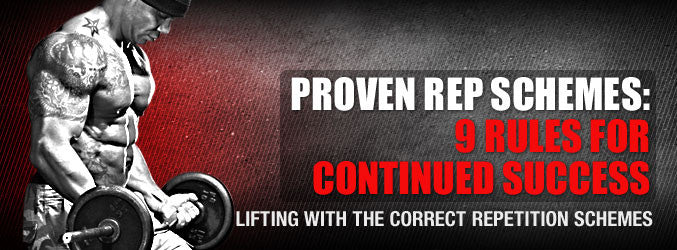
Repetition schemes are among the most confused and abused components of lifting, for bodybuilders and powerlifters alike. Getting a grip on you 1RM and what % to use for each set, in order to reach your goals, is one of the most important things that a lifter can achieve. Are you ready to learn the basics, then go beyond?
The first thing every lifter should remember is that no rep/set scheme is ideal for every goal. Each set of goals is different, and the number of repetitions with % of maximum 1RM poundage used will affect how quickly each goal is reached, if at all. If you’re training with 30-repetition sets on chest day, you’re not going to break any powerlifting records. If you only train with one-rep maximum lifts, you’ll never achieve a Frank Zane type of physique with complete development. Let’s look at some general rules to follow when setting in motion your lifting with the correct repetition schemes.
Keep it varied
While certain premises remain true (IE: Low repetitions lead to strength, etc), some variance in exactly how many repetitions you are using (and with what % of 100% 1RM will allow you to keep improving your strength and muscle mass levels. The alternative would be to continue using the exact same training system all of the time. The body adapts very quickly to any training strategy.

Ramping up for strength
If your goal is pure strength gains, then training very heavy is going to be the key to your success. Use a training partner, warm up thoroughly, and learn your 1RM, or one repetition max, for each mass-building compound exercise you plan on using in the gym each week. Your training will involve a series of “5RM” or “2RM”s. This is simply the amount of weight you can move for 5 or 2 repetitions, respectively.
Ramping up is a wonderful strategy to use for a variety of reasons. Your nervous system will be activated, increasing potentiation, and increasing the performance ability you’ll possess for all subsequent sets. Fatigue of the muscular and neural variety will occur at the same time, causing a decrease in your performance potential. Finding the ideal balance between the two can be tricky. Speed of acceleration on each repetition can assist in getting the most bang for your training buck without incurring injury.
Make it gradual
Keeping your workouts mathematical and using a journal to record everything is a great way to see sustained results. Once you know your 1RM, 2RM, 5RM, and even 10RM, you can put them to work. Start gradually, aiming for sets of 10 to 12 repetitions to start, using weight as low as 60% of your one-repetition maximum. With each subsequent set, you should reduce the number of repetitions while moving up the weight. 60% works great for set 1. Move that to 70% for set 2. Make it 80% for set 3. The next thing you know, you’re at 90% of your 1RM for that fourth and final set. Things are starting to get heavy!

Training for Maximum Size
If the goal is to build pure muscle size and shape, as is the goal of many bodybuilders, then you will want to train with numbers like 4 x 8 (4 sets of 8 repetitions) or 6 x 6 (six sets of six reps).
5 x 5
For building strength and adding size, the classic 5 x 5 is tried and true. Use 5 sets of 5 repetitions each, working up to your 5 repetition maximum. If you can move 200 pounds for 5 repetitions, then your 5RM is 200. 80% of your 5RM would be 160 pounds. 90% of your 5RM would be 180 pounds. 95% of you 5RM would be 190 pounds. You get the idea. The closer you are to 200 pounds, the more you are training for strength, and not muscle size and shape.
Follow the rep rules
If you’re only supposed to train with 8 repetitions for a set, and you feel that you can actually complete more repetitions – you should NOT. Rather, you should take a note and re-evaluate how much weight you assigned yourself for that set. Is it accurate? Alternatively, you can work to complete these repetitions in a FASTER movement, which will continue to increase muscle fiber stimulation, while at the same time helping you to dodge the fatigue which occurs during the longer, slower sets.
Skip the warm-ups
Your light sets ARE the warm-up sets. They aren’t included because they are likely to siphon energy away from training at maximum capacity. Bodybuilders love warm-up sets. You love moving big heavy weight and getting stronger. That happens when you get to that 1RM as quickly and as safely as possible. Four sets is optimal. More sets than this, and you’re wearing yourself out. Fewer sets and your muscles are not likely to be ready for the big blast of 1RM pain to which you’re about to expose them.
5/4/3/2/1/1
This method is a simple one. Knock out 5 reps with 80% of your 1-repetition maximum. Then, complete 4 reps with 82%, 3 reps with 85%, 2 reps with 90%, and then one repetition with 95%. Finally, go for 1 repetition with 100% of your 1RM weight. And if you’re feeling strong, move on to 102% and go for a personal record, if you’re training with a partner and feeling exceptionally strong and capable today!
Rest-Pause
This training method is a great one for lifter of all ages and experience levels. Pick up a weight that is about 80% of your 1 RM, and complete six repetitions. Put the weight down, rest for 15 to 20 seconds, then pick up the weight and try to complete another 4 repetitions, using the same weight. This very demanding training protocol should be used sparingly as it will lead to great soreness, but you’ll add some great muscle as well!


